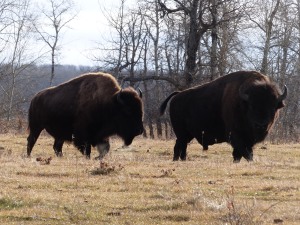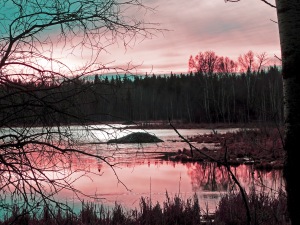It’s not often I do an article specifically on one of western Canada’s National Parks
but I have had some opportunity this past year to spend time in Elk Island National Park, the park has a diverse Eco system of birds, waterfowl and mammals.
The park was established in 1913 and Elk Island is home to the densest population of ungulates (hoofed mammals) in Canada. A variety of mammal species including coyote, bison, moose, mule deer, lynx, beaver, elk, white-tailed deer and porcupine are year-round residents and the park usually receives one or two bear sightings each year. Elk Island National Park is situated in the Beaver Hills – an area, as the name suggests, abundant in beaver at the turn of the 19th century. What made the Beaver Hills unique was the aspen thickets which surrounded the prairie and provided forage and protection for the wintering herds of bison and year-round population of elk, moose, and deer. And there was plenty of water.
The Beaver Hills became an important center for much of the commercial hunting, which supplied the fur trade. Beaver were virtually eliminated from the Beaver Hills by the 1830s. As late as 1841 bison were still being obtained in large numbers from the Beaver Hills. But they were quickly being depleted. By the late 1860s, the numbers of large ungulates were depleted to the point where the bison were almost eliminated and other large herbivores were very scarce.
Most of the lands in the Beaver Hills remained untouched from the 1870s through the homestead period. The remaining forest resources were viewed by some as a valuable timber resource, by others as a hindrance to settlement. In 1895 fire devastated the area. This prompted the federal government to protect the forest and in 1899 the area was officially designated as ‘The Cooking Lake Forest Reserve.’
Although the forest was protected, the elk and mule deer were not. Sport hunting and hunting for meat by the settlers posed a threat to wildlife populations. Those elk which were present in the Beaver Hills were considered one of the last herds in Canada.
A 2.2 meter fence was constructed around the area, which included the area around present day Astotin Lake. With elk, mule deer, and moose enclosed within its fenced boundaries, Elk Park became the first federally controlled area in Canada to be enclosed as a big game sanctuary. This marked a new era in conservation in Canada. Dominion Parks, at this time were recognized informally as ‘wildlife parks’ and ‘scenic parks’. Elk Island Park, as it was called in 1908, was wildlife park until it became formally designated as a Dominion Park in March 1913. The National Parks Act, when passed by the Canadian Parliament in 1930, established Elk Island as a national park. National parks were established, during this time, to provide sanctuary for wildlife – sanctuary from uncontrolled hunting, trapping and loss of habitat. The act dedicated National Parks to both ‘preservation’ and ‘use’ by the people of Canada. Protection thus established, tourism followed.
Certainly no one realized what a treasured resource this sanctuary would become. When Elk Park was established in 1906, it consisted of a 42 square kilometer area surrounding the lake locally known as Island Lake (now known as Astotin Lake). The lake is dotted with small islands-Lamont, Archer, and Elk Island to name a few. As the name suggests, Lamont Island was named after the local community, Archer Island bears the name of a prominent local physician, and Elk Island was named for the elk, which swam out to the island to calve.
 In 1913, the name Elk Island Park was selected. The Park did have two outstanding features-elk and Island Lake with its sandy beaches and islands. Today, the significance of the name distinguishes the fact that the National Park is an island in many ways – an island of protection for the heritage resources within its boundaries and an island refuge for people seeking to escape from the urban hustle and bustle. Elk Island National Park is recognized as ‘an island of nature surrounded by a landscape of man.’
In 1913, the name Elk Island Park was selected. The Park did have two outstanding features-elk and Island Lake with its sandy beaches and islands. Today, the significance of the name distinguishes the fact that the National Park is an island in many ways – an island of protection for the heritage resources within its boundaries and an island refuge for people seeking to escape from the urban hustle and bustle. Elk Island National Park is recognized as ‘an island of nature surrounded by a landscape of man.’
The park is entered by passing over a “cattle gate”, the ribbed metal structure dissuades the bison from attempting to get outside the fenced compound, you have now entered the 194 sq. kilometer habitat of the bison where they are free to roam the park at will and travelling on foot within the park must be done with care.
I managed two trips by motorcycle to the park this year and did not see any bison on either trip, in the heat of the summer they tend to stay in the trees away from the parkway which splits the park from north to south. A return trip in my vehicle after the weather had cooled and the first light snow had fallen produced the results I was looking for, I arrived in the park just as the sun was coming up and the bison were moving from the shelter of the bush to the open sunny areas to graze and warm up. They did not seem to pay my vehicle much attention, I would sit with the window down and the engine off and let them move past me, once they had all passed I would relocate and let the process happen all over again. A couple of times one of the big mature bulls wandered past me, close enough that I was glad to be in a vehicle and not sitting on an exposed motorcycle.
It’s about time for another trip to the park, more snow has fallen and the park will look completely different from before but hopefully this time of year the bison are following a fairly predictable daily pattern.
Park statistics gathered from Parks Canada websites.

